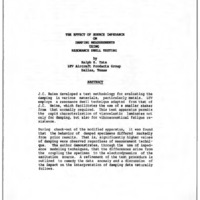-
Title
-
The Effect of Source Impedance on Damping Measurements Using Resonance Dwell Testing
-
Report Number
-
WL-TR-91-3078 Volume III, p. IBA-1 thru IBA-14
-
Creator
-
Tate, Ralph E.
-
Corporate Author
-
LTV Aircraft Products Group
-
Date
-
1991
-
Date Issued
-
1991-08
-
Extent
-
14
-
Identifier
-
ADA241313
-
Format
-
1 online resource
-
Abstract
-
J.C. Heine developed a test methodology for evaluating the damping in various materials, particularly metals. LTV
employs a resonance dwell technique adapted from that of J.C. Heine, which facilitates the use of a smaller shaker
from that normally required. This test apparatus permits
the rapid characterization of viscoelastic laminates not
only for damping, but also for vibroacoustical fatigue resistence. During check-out of the modified apparatus, it was found that the behavior of damped specimens differed markedly from prior results. That is, significantly higher values of damping were observed regardless of measurement technique. The author demonstrates, through the use of impedance modeling techniques, that the differences arise from the coupling the specimen to the electrodynamics of the excitation source. A refinement of the test procedure is outlined to remedy the data anomaly and a discussion of the impact on the interpretation of damping data naturally follows.
-
Description
-
J.C. Heine developed a test methodology for evaluating the damping in various materials, particularly metals. LTV
employs a resonance dwell technique adapted from that of J.C. Heine, which facilitates the use of a smaller shaker
from that normally required. This test apparatus permits
the rapid characterization of viscoelastic laminates not
only for damping, but also for vibroacoustical fatigue resistence. During check-out of the modified apparatus, it was found that the behavior of damped specimens differed markedly from prior results. That is, significantly higher values of damping were observed regardless of measurement technique. The author demonstrates, through the use of impedance modeling techniques, that the differences arise from the coupling the specimen to the electrodynamics of the excitation source. A refinement of the test procedure is outlined to remedy the data anomaly and a discussion of the impact on the interpretation of damping data naturally follows.
-
Distribution Classification
-
1
-
Distribution Conflict
-
No
-
DTIC Record Exists
-
No
-
Illinois Tech Related
-
No
-
Photo Quality
-
Not Needed
-
Report Availability
-
Full text available
-
Type
-
article
 articleIBA
articleIBA